Speed, efficiency, and accuracy are the keys to a smooth production workflow, and new artificial intelligence (AI) video search technology from Strada is potentially the golden ticket to this exciting world of possibilities. Strada automatically transcribes audio; tags objects, people, and locations in video; and generates metadata.
But there’s a catch: The main challenge is the time it takes to ingest large files to the cloud so users of Strada and other AI platforms can run AI workflows.
- If you’ve uploaded anything to one of Strada’s three supported cloud platforms—Google Drive, Dropbox, or Frame.io—you know the process is painful.
- Dropbox and Google Drive are not optimized for video files, which has left more than a few creatives with a bitter taste in their mouths.
I recently had a chance to taste test the Strada beta. It reminded me that while connecting cloud storage to Strada is easy, ingesting large video files to those platforms bites. Luckily, we at MASV have an easy way of dealing with this problem.
目次
Easily Ingest Content to Multiple Clouds
Professional filmmakers rely on MASV for large file transfers.
What is Strada?
Strada is an AI platform that helps filmmakers start crafting stories sooner by automating processes common in media production. It offers AI powered search, making it bit like an AI search engine for your video data. It allows for seamless organization without manually sorting through hours of footage, and freeing up time to focus on creativity instead of searching for relevant video.
Strada presents its capabilities in a well-laid-out browser experience that provides a visual representation of what’s found in your video content—and, most importantly, when it’s found—in an editor-friendly timeline format.
Strada offers several benefits for filmmakers, including:
- Collaboration: Multiple users can access shared media and assets in real time to work on projects simultaneously.
- AI-powered automation: Strada uses AI for transcription, tagging, and metadata creation, saving time by automating traditionally manual processes.
- Multi-cloud インテグレーション: Strada connects to popular cloud services like Google Drive, Dropbox, and Frame.io.
- Streamlined media organization: Tagging and indexing features allow users to quickly browse search results and pinpoint footage within a vast video library—a bit like a Google search of your video content, but even more powerful.
Because Strada leverages the power of the cloud it’s like having thousands of assistant editors working in the background, each one diligently tagging everything you could possibly imagine. I hate to say it, but it’s like having an army of Oompa-Loompas keeping the factory running.
Available cloud integrations
Strada is awesome when your footage already lives in the cloud. But anyone who has uploaded to one of the three currently supported cloud platforms will tell you the process is painful.
Upload limitations inherent in Google Drive, Dropbox, and Frame.io can cause delays, slowing down collaboration and overall productivity—basically, everything Strada tries to avoid.
But there is a better way.
How MASV Speeds Up Your Strada Workflow
MASV is specifically designed for fast and reliable large file transfers, making it the perfect tool to overcome slow ingestion to the cloud and ingest huge datasets to the cloud for AI processing.
The really great thing is that MASV works with Strada today—even in its current beta form.
- By integrating MASV into a Strada workflow, you can quickly upload and transfer massive video files into Strada’s supported cloud platforms.
- We can take it even further and ingest data into connected on-prem storage. This means faster access to media for processing and collaboration. With MASV’s capability to deliver files at speed Strada users can drastically reduce their turnaround times, enabling more efficient workflows.
Ingest to multiple cloud locations
MASV excels in spinning up efficient one-to-many upload workflows. When users upload files through a MASV Portal integrated with specific cloud storage and preconfigured to automate uploads to those destinations, they aren’t just sending them to one spot—they’re launching them directly to multiple cloud storage systems without uploading and downloading over and over again.
Ingest to on-prem storage
MASV also has the unique ability to ingest directly to a NAS like Synology or QNAP via 集中インジェスト.
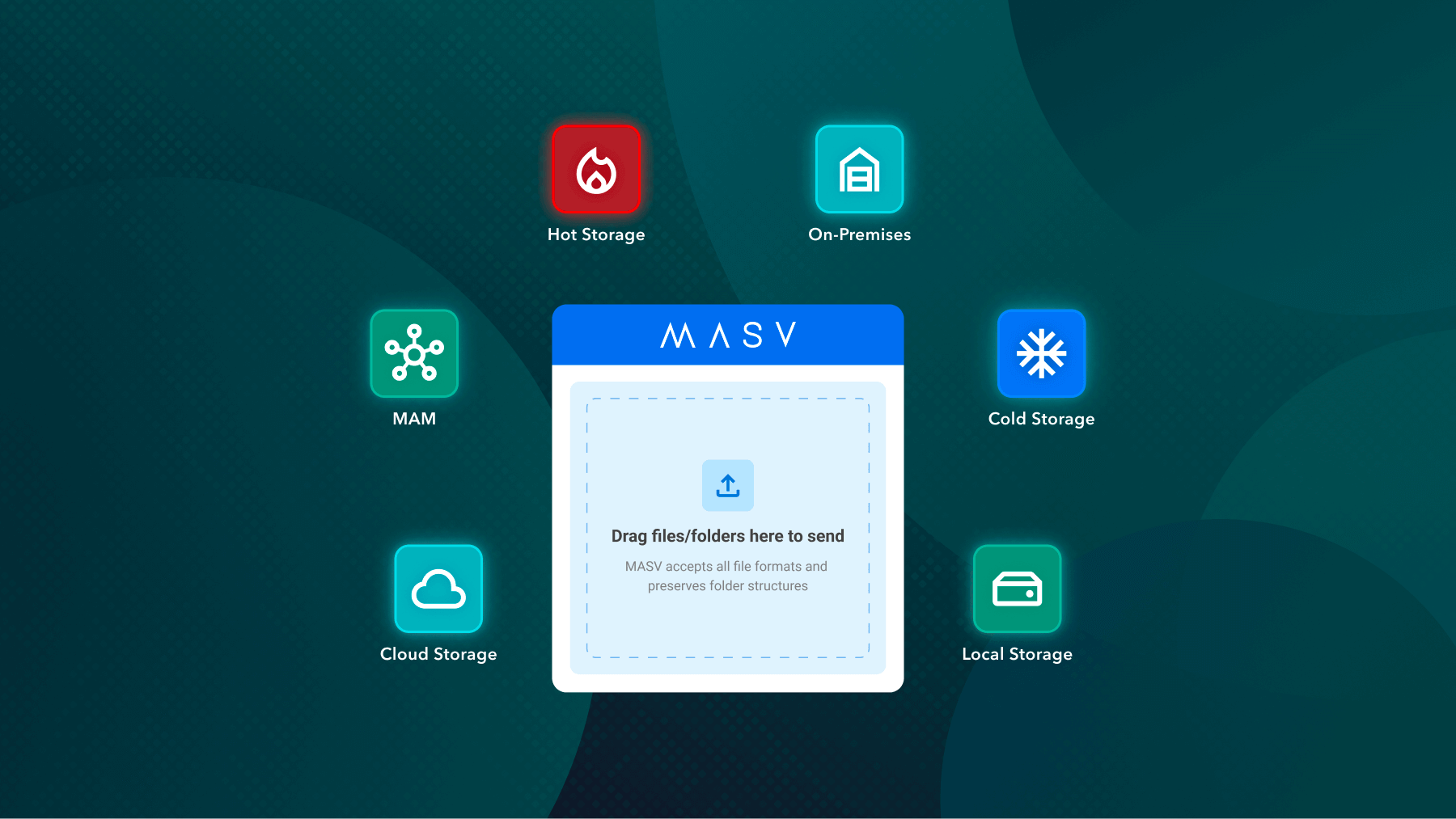
This is great for AI processing workflows because even though Strada has access to cloud storage to do its AI analysis, we still need to be able to work with the footage. And the best way to do that is to be physically connected to a ネットワーク接続ストレージ (NAS). Why?
- Faster access to media: You get faster access to files compared to cloud storage, reducing wait times.
- Improved collaboration: With a NAS everyone can access and work on the same files at the same time, all from one centralized hub. No file duplicates or slow transfers.
- Reduced latency for high-resolution media: Working with high-res video directly from a NAS is like having your own express lane. Even cloud-based services like LucidLink and Suite Studios need a fast cache drive to offer peak performance.
💡 The MASVエージェント is a cross-platform service that manages MASV file transfers. Once it’s set up on a NAS, that NAS becomes an available storage destination for anything uploaded to your chosen MASV Portal. Any files uploaded via the MASV Portal are automatically transferred to pre-designated NAS folders.
This integration unlocks the factory doors of cloud-based workflows by ensuring fast and reliable access to high-resolution media without manual downloads. MASV Storage Gateway is key to hybrid workflows that balance the flexibility of cloud access with the efficiency of local storage.
The Strada-MASV Workflow
With this workflow we just need one location for Strada to access our files —either Frame.io, Dropbox, or Google Drive. We’re going to ingest our footage to Frame.io for Strada access, but also use AWS S3 to back up our footage.
Tools we used:
Here are the tools (both hardware and software) we’re going to use in this workflow:
- MASVデスクトップアプリ: High-performance desktop file transfer app built to enable blindingly fast file transfers and no-code automations.
- Frame.io: Cloud storage and media asset management.
- Synology NAS: On-prem, connected, shared storage for raw and proxy files.
- Amazon S3: Ultra-scalable cloud object storage.
- Strada: Platform for AI-powered visual and audio search.
- DaVinci Resolve(ダヴィンチ・リゾルブ: Non-linear editor.
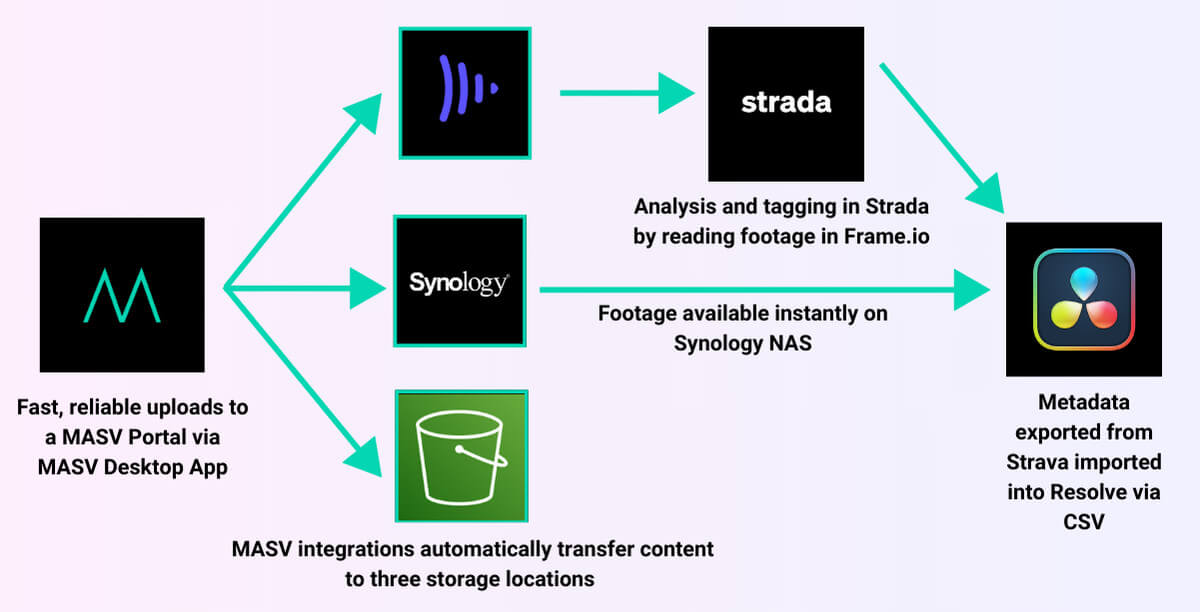
1. Set up integrations
First things first: We’ll create a MASV Portal, set up our integrations, then connect them to the Portal.
- Create a MASV Portal.
- Connect Frame.io to MASV.
- Connect AWS S3 to MASV.
- Connect Synology to MASV.
We’re using Frame.io as the cloud storage platform in this workflow, but you can use any cloud storage platform that Strada and MASV currently support. We’re using Frame.io because we want to make the footage available to the team for review and commenting.
We’ve also connected the MASV Portal to our Synology NAS and an S3 bucket. That’s because we want to make sure original assets are delivered to my NAS so we can work with those files locally inside our NLE. Footage will also go to an AWS bucket for backup.
💡 MASV can also send files from cloud storage—no need to re-download your footage to send to another recipient!
Automatic ingest with MASV Portals
We’re now ready to use the MASV Desktop App to upload our footage to Strada!
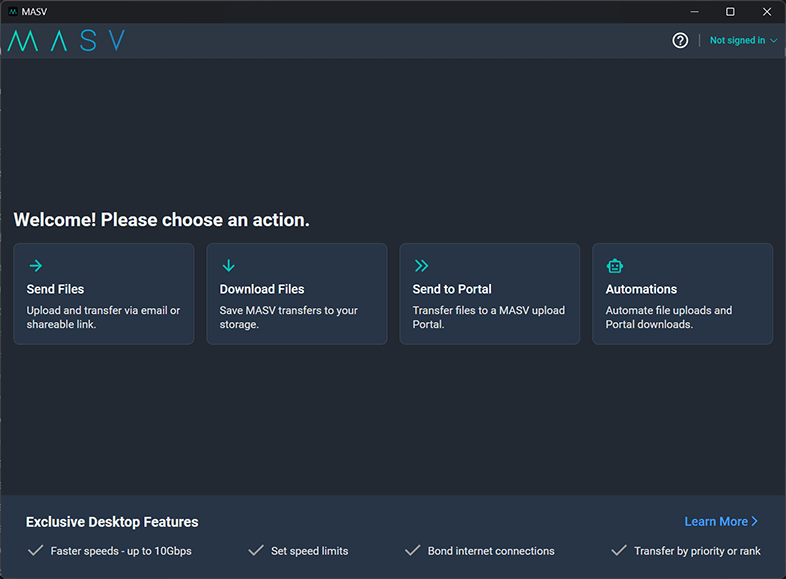
With our Portals configured and connections made in Strada, do the following:
- Open the MASV Desktop App (you’ll first need to download it and sign in to your MASV account within the App).
- Select Send to Portal inside the App, and enter the Portal URL.
- Drag and drop the files you want to upload.
- Hit Send.
- Grab a Whipple-Scrumptious Fudge-Mallow Delight (or your choice of snack).
When the upload is finished, MASV will send you an email letting you know. This workflow has been configured so the Portal immediately sends files to Frame.io, S3, and our Synology NAS.
Connect Frame.io and Strada
We’re now ready to connect our Frame.io account to Strada! We’ll walk you through the steps to integrate Frame.io with Strada, making sure Strada can access all your media.
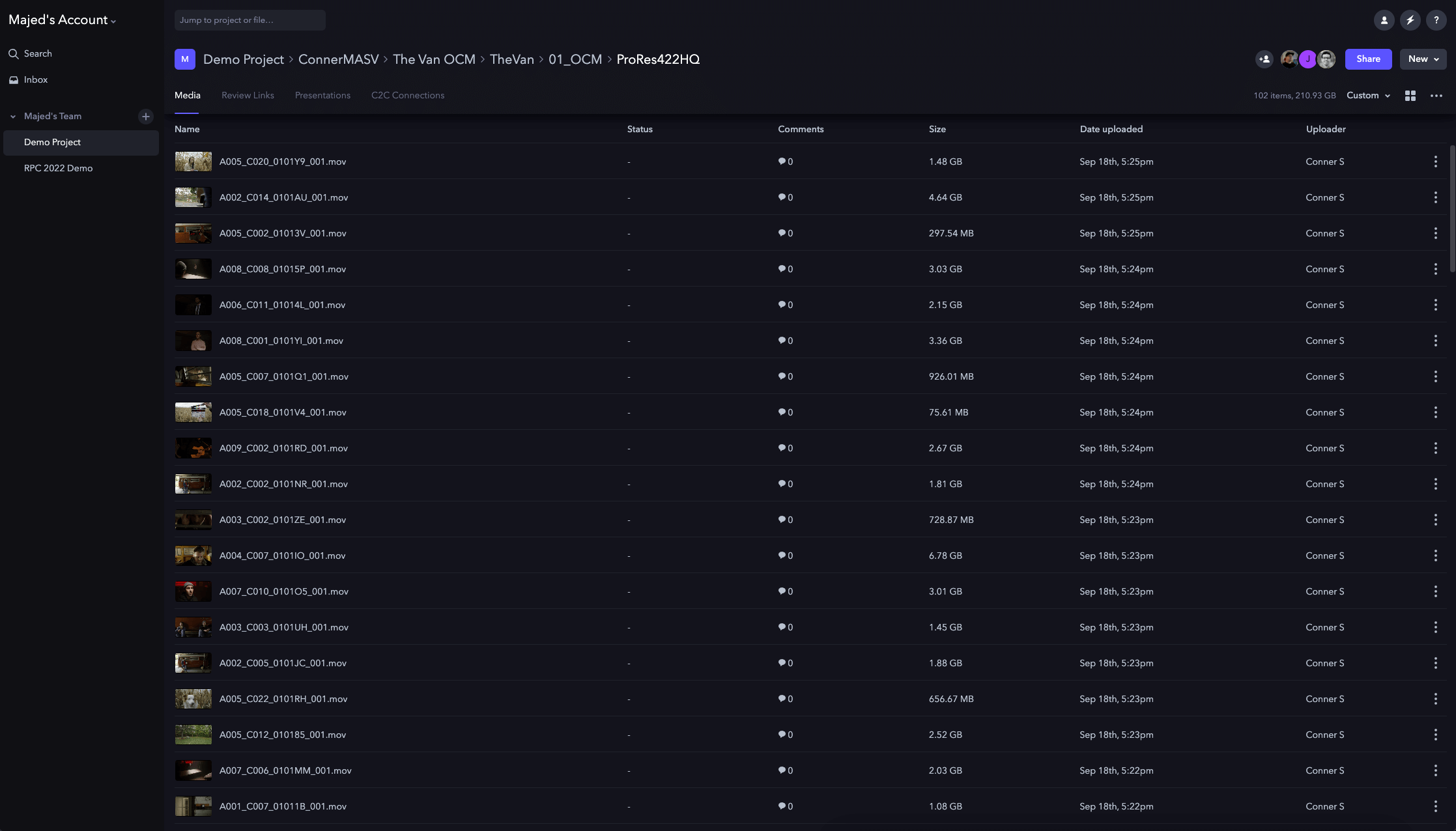
It’s an extremely straightforward process:
- Log in to Strada.
- Click the plus sign on the right of the screen to add cloud storage (Google Drive, Frame.io, or Dropbox are the current options).
- For this workflow, we’ll select Frame.io.
- Log in to Frame.io.
- Give Strada permission to access your files within Frame.io.
Perform AI analysis in Strada
We can now navigate to our footage inside Strada and get it set up for processing.
Here’s how to do it:
- Create a new project inside Strada.
- Navigate to your footage in cloud storage (in our case, this is Frame.io).
- Drag your footage into a Strada bin to add it to the project.
- Select the footage and right-click to bring up the contextual menu.
- Select Analyze.
- If you want to transcribe your footage as well, repeat step 4 and select Transcribe.
- Strada is now analyzing your footage!
Download and ingest Strada metadata
OK, so at this point, Strada’s AI technology has analyzed and transcribed all of our footage, along with adding tags and metadata. But now I need to get all that inside DaVinci Resolve so I can start searching and editing there.
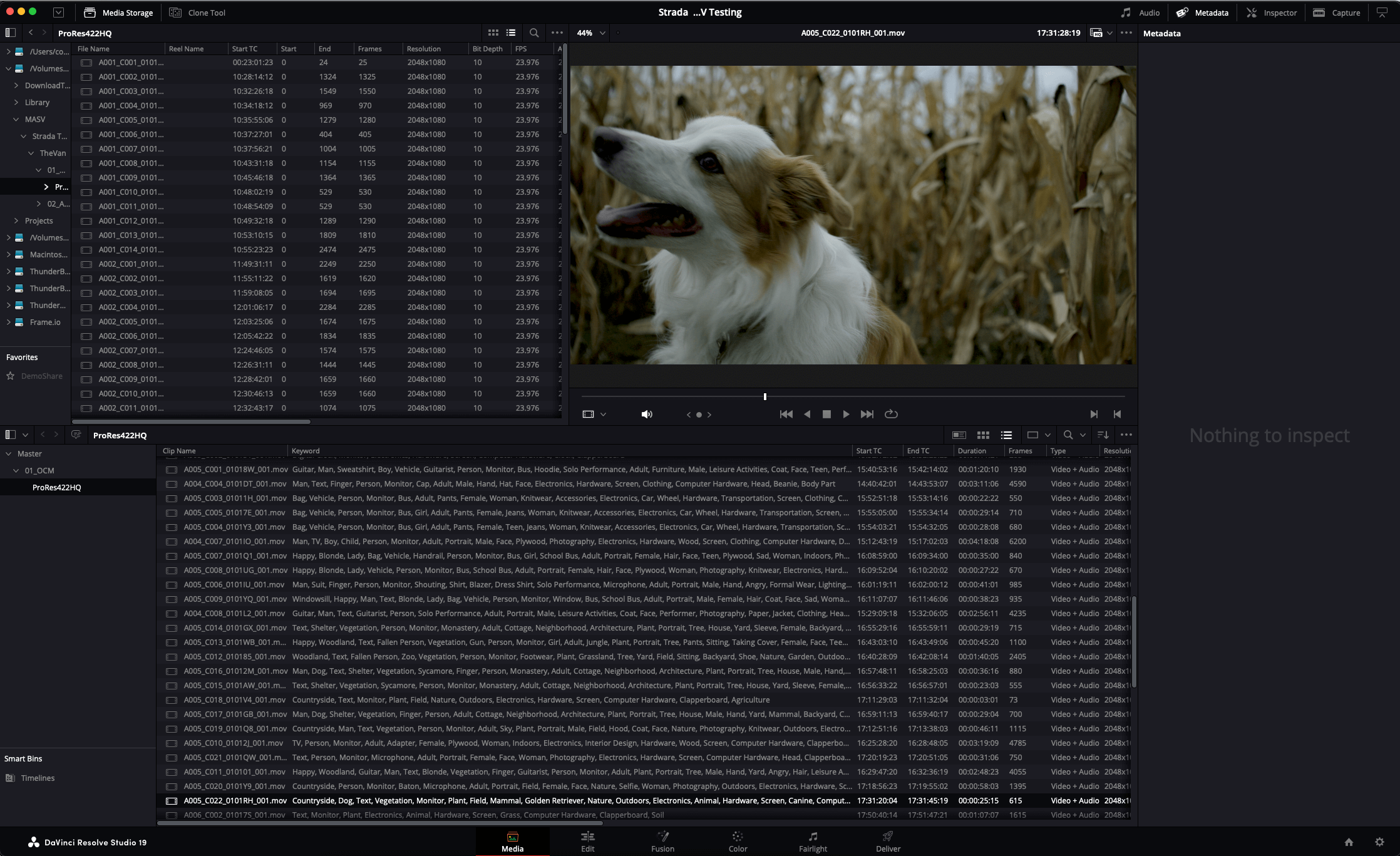
In this case, the footage is already on my Synology NAS, and I’ve already imported the footage and set up my DaVinci Resolve project.
- Select the analyzed footage.
- Right-click and select Download Metadata-> Resolve CSV.
- Navigate to your project in DaVinci Resolve.
- Navigate to File-> Import Metadata To-> Media Pool and select the downloaded CSV. Strada will now import the tags as keywords into DaVinci Resolve.
Search your for your clips and start cutting!
With our footage analyzed and keyworded, we can now quickly narrow in on the clips we need to tell our story without manually searching hours of footage.
MASV Free Tier and proxies on Strada
It’s also worth mentioning that MASV can also improve proxy workflows for Strada.
- In this case, I had about 300GB of ProRes 422 HQ footage, which ran about three hours.
- Proxies of that footage clocked in at close to around 9GB of H.264 files— which just so happens to be under the 10GB per month that MASV gives users for free.
This means you could use MASV to get your project into Strada using proxies for free, every single month, with MASV.
Everything always tastes better when it’s free!
MASV: The Best Data Ingestion Tool for AI Video Search
After testing this workflow, we feel confident saying that MASV is the fastest and most flexible ingest tool for Strada or other AI video search tools, hands down.
Using the native uploader to get video files into Frame.io, Dropbox, or Google Drive doesn’t even come close to the speed or efficiency of MASV.
- Not only does this help alleviate one of the biggest hurdles in media workflows—slow file transfers—but it does so with an easy-to-use interface and no-code automations that make media available and ready to work with in multiple locations.
- MASV’s ability to handle large files of up to 15TB (or file packages of unlimited size) quickly and securely eliminates ingest bottlenecks caused by traditional cloud storage services.
Seamless integrations between MASV and these storage platforms allows faster uploads, reducing the time spent waiting for files to be available in Strada for AI-powered processing. Whether you’re working on cloud-based projects or using your local Synology or QNAP storage, MASV offers the flexibility, speed, and reliability needed to enhance any media production workflow.
MASV and Strada really are the perfect pairing. But the best part? You can sign up for MASV for free to try it for yourself.
Ingest Really, Really Big Datasets to the Cloud
Kickstart AI workflows by uploading huge. datasets to the cloud fast and reliably.